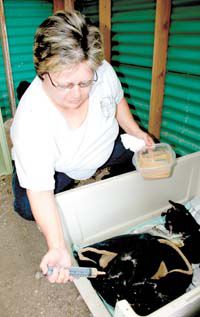| Second Chance Wildlife Rehabilitation Center owner Debbie Pappas feeds a clutch of ravens. The birds were orphaned when their mother was shot. |
A visit to Second Chance Wildlife Rehabilitation Center on May 18 showed how much work and effort goes into treating a pair of avian species.
Debbie Pappas, operator of the non-profit organization, is currently nursing a group of baby screech owls and ravens back to health and, hopefully, preparing the birds for release back into the wild.
The ravens were found in Utah County and brought to Pappas by another wildlife rehabilitation manager.
The young birds were orphaned when someone shot and killed their mother.
“We have had these little guys for about a month,” said Pappas. “And they will be with me for another six to eight weeks.”
The center will have to teach the birds to feed in the wild while managing their weight before they can be released, noted Pappas.
“We also make them exercise and fly as much as possible while teaching them to feed, which is easy with ravens because they eat everything,” explained Pappas.
According to pbs.com, ravens have long been recognized as one of the most intelligent birds.
Ravens have also maintained a less than savory image throughout history as a scavenger that does not discriminate between humans and animals.
Ingenious and versatile, ravens are members of the crow family, which includes jays and magpies.
The species is found everywhere in the northern hemisphere and adapts to different terrain, from deserts to mountains.
| Three baby screech owls await feeding from Second Chance owner Debbie Pappas. The birds were knocked from their home in Utah County when a land owner cut down the tree which held their nest. |
“Being able to survive anywhere takes a lot of intelligence,” said Pappas.
The site goes on to report that ravens find food even in the harshest conditions, such as the dead of winter in Yellowstone National Park.
As scavengers, ravens know how and when to take advantage of other animals to help capture a meal the birds otherwise couldn’t reach.
While the screech owl is also a bird of prey, it is quite different from the raven.
Screech owls are quite adaptable and often will live in suburban areas if suitable nesting sites are available.
The behavior proved to be a problem for a family of screech owls in Utah County when a land owner cut down the tree harboring the birds’ nest.
“Once the nest was knocked to the ground the parents abandoned their young,” explained Pappas. “I would like to remind land owners to please check trees for active nests before cutting them down,” continued the local rehabilitation center’s operator.
The owls have been at the center for three weeks and will remain at the center for at least another five to six weeks to complete the rehabilitation process.
“They must be taught to hunt for prey in the wild,” commented Pappas. “We do that by first feeding them dead prey and then moving on to the live stuff, so they can learn to catch it. The positive thing with a whole nest is that once one of the babies pick up on the hunting behavior the others will copy and catch on quickly.”
According to wildwnc.org, screech owls were named for the calling sound the birds make.
The species ia so small that the birds often are confused for baby great horned owls.
Owls are quite unique birds, continued Pappas. Although they are classified as raptors, owls are very different from many other birds of prey in autonomy, feather structure and hunting techniques.
Owls are noted for the birds’ large heads and eyes, which are fixed in the skull. The anatomy makes it necessary for owls to rotate their heads in order to change their view.
Owls’ hearing is very acute. In many species, the ears, which are crescent-shaped slits beneath the facial feathers, are placed asymmetrically on the head in order to better pick up sound.
Owls also have a distinctive facial disk which helps to direct sound towards the ears.
The flight of an owl is almost noiseless due to tiny fringe-like structures found along the outer edge of each feather. This allows an owl to fly silently toward its prey without detection.
“While these cute little owls have been great to have, we are careful not to pet or handle them, we don’t want them liking people when we set them back into the wild,” explained Pappas.
“Things are going well at the center but we really need some help,” continued Pappas.
The shelter needs food and medical supplies of all types, ranging from gauze to syringes and to latex gloves. The food in the form of meat is typically doated by hunters and other local residents.
“But most of all I need bodies,” said Pappas. “People who are willing to give their time to help injured wildlife.”
For additional information, Carbon County residents may contact the Second Chance Wildlife Rehabilitation Center on Carbonville Road.

